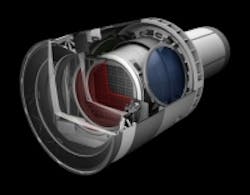The U.S. Department of Energy (DOE) has granted “Critical Decision 2” funding approval for the plans to construct the world’s largestcamera at the SLAC National Accelerator Laboratory.
MORE ARTICLES
Reprocessed image shows color view of Jupiter’s moon Europa
(Slideshow) Vision Systems Design hottest topics of 2014
Infrared detector from Sofradir launching on Japanese Hayabusa2 spacecraft
The 3,200 MPixel centerpiece of theLarge Synoptic Survey Telescope (LSST) will be used for in-depth study of the universe, helping researchers to study the formation of galaxies, track potentially hazardous asteroids, observe exploding stars, and better understand dark matter and dark energy, which make up 95% of the universe but whose nature remains unknown, according to SLAC.
"This important decision endorses the camera fabrication budget that we proposed," said LSST Director Steven Kahn. "Together with theconstruction funding we received from the National Science Foundation in August, it is now clear that LSST will have the support it needs to be completed on schedule."
The LLST camera is comprised of an array of 189 tiled 4k x 4kCCD image sensors and an 8.4m primary mirror. The sensors will be organized into identical “rafts” of 3 x 3 sensors that are autonomous objects that can function as a complete camera at 144 channels/raft, according to the LLST project page. A 16-bit dynamic range is handled by single-gain readout. The camera will be cryogenically cooled to -100°C and will have a readout time of 2 s or less, and will operate at wavelengths from 320 to 1060 nm.
Thecomponents of the camera will be the size of a small car and weigh more than 3 tons, and will be built by an international collaboration of labs and universities, including DOE’s Brookhaven National Laboratory, Lawrence Livermore National Laboratory, and SLAC, where the camera will be assembled and tested. Science operations for the LLST are scheduled to start in 2022, with the camera capturing images of the entire visible southern sky every few nights from atop a mountain called Cerro Pachón in Chile. It will produce the widest, deepest and fastest views of the night sky ever observed, according to SLAC.
During a 10-year time period, the observatory will detect tens of billions of objects, which is the first time a telescope will catalog more objects in the universe than there are people on Earth. During its usage, the LLST will generate approximately 6 million GB/year, which will aid in thestudy of the universe.
"The telescope is a key part of the long-term strategy to study dark energy and other scientific topics in the United States and elsewhere," said David MacFarlane, SLAC’s director of particle physics and astrophysics. "SLAC places high priority on the successful development and construction of the LSST camera, and is very pleased that the project has achieved this major approval milestone."
The next phase for the LLST team is the "Critical Decision 3" review process next summer, which is the last requirement before actual fabrication of the camera can begin.
View theSLAC press release.
Share your vision-related news by contactingJames Carroll, Senior Web Editor, Vision Systems Design
To receive news like this in your inbox,click here.
Join ourLinkedIn group | Like us on Facebook | Follow us on Twitter| Check us out on Google +
About the Author

James Carroll
Former VSD Editor James Carroll joined the team 2013. Carroll covered machine vision and imaging from numerous angles, including application stories, industry news, market updates, and new products. In addition to writing and editing articles, Carroll managed the Innovators Awards program and webcasts.
